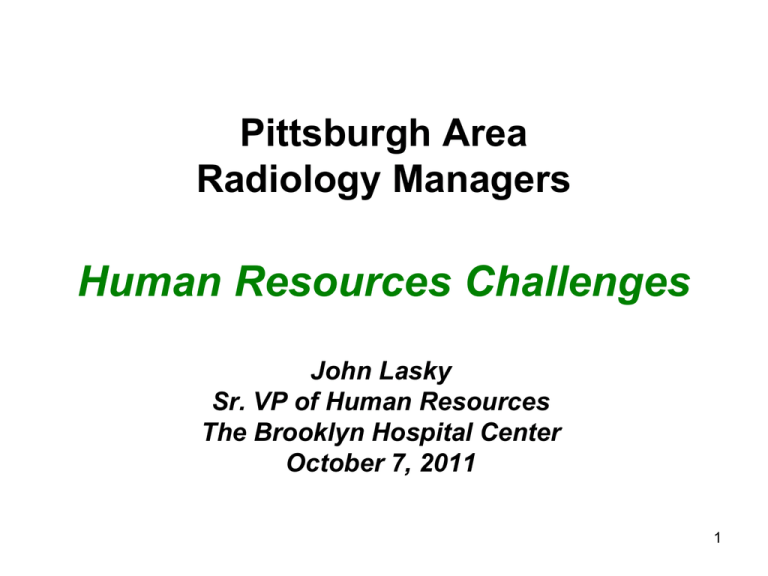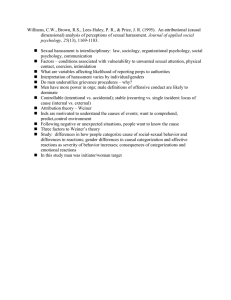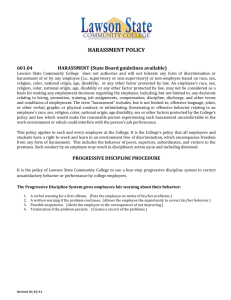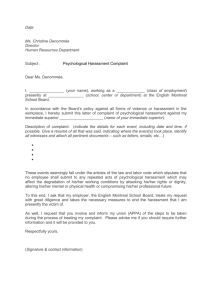
Pittsburgh Area
Radiology Managers
Human Resources Challenges
John Lasky
Sr. VP of Human Resources
The Brooklyn Hospital Center
October 7, 2011
1
1. Harassment
2
Let’s Do the Math
Once upon a time . . . *
• “Somewhere around 50% of Americans
meet their spouses at work.”
(L. Stasi and R. Rogers, Boomer Babes, 1998)
• “[S]ome 75% of people meet their spouses
at work.”
(www.strategyworld.com, October 20, 2003)
• So what is the appropriate conclusion?
• *Let’s update
3
Let’s Do the Math
• Divorce rate, United States
– Ist marriages
50%
– 2nd marriages
67%
– 3rd marriages
74%
– By the way, cities with Major League Baseball
teams have a 28% divorce rate
Jennifer Baker, Forest Institute of Professional Psychology,
Springfield, MO (reported in www.businessweek.com (April 14, 2009)
• So what is the appropriate conclusion?
4
Also . . .
• The current economic climate
– Its impact on employees
• Consider
– “KKK leader convicted of possessing pipe
bombs; Washington County Klan leader to be
sentenced” Sept. 17 (pg.com, 5/29/04)
– “A jury convicted two Pennsylvania men
Thursday of a federal hate crime in the fatal
beating of an illegal Mexican immigrant,
finding they attacked the man primarily out of
hatred for Hispanics.” (Daily Times, 10/14/10)
5
Let’s Do the Math
2005
2006
2007
2008
Total
75,428
75,768
82,792
95,402
Race
26,740
27,238
30,510
33,937
Sex
23,094
23,247
24,826
28,372
Nat.
Origin
Religion
8,035
8,327
9,396
10,601
2.340
2,541
2,880
3,272
www.eeoc.gov:
Complaints
6
Harassment: Prohibited Conduct
Any policy should be straightforward:
• We will maintain a working environment free
from any form of forbidden harassment,
including harassment based on:
–
–
–
–
–
–
–
–
–
Sex
Ethnic Background
Age
Religion
Disability
Pregnancy
Race
Color
(Sexual orientation)
7
Scope of Protection
This policy protects everyone . . .
Employees
Applicants
Patients
Any visitors . . .
From any unwelcome conduct that is known
(or should be known) to be offensive based
on any protected characteristic.
8
Scope of Protection
The difference between
“forbidden harassment”
and other harassment . . .
are all complaints of
“harassment” equal?
9
What is “Forbidden” Harassment?
1st type: "Quid Pro Quo" Sexual Harassment.
Unwelcome sexual advances, requests for sexual
favors, or other verbal or physical conduct of a
sexual nature, when:
(i) submission to such conduct is a condition of
employment, or
(ii) submission to or rejection of such conduct is
used as the basis for employment decisions.
10
What is “Forbidden” Harassment?
2nd Type: Hostile Environment Harassment.
Unwelcome sexual advances, requests for sexual
favors, or other verbal or physical conduct of a
sexual nature.
Also, non-sexual conduct that is unwelcome and
offensive and which is directed at an individual
because of his/her protected characteristic.
Conduct motivated by or relating to a person’s
race, age, religion, ethnicity, disability, or other
protected characteristics.
11
What is “Forbidden” Harassment?
Hostile Environment Harassment.
Elements:
Conduct is unwelcome, offensive, and sufficiently
severe or pervasive and:
(i) unreasonably interferes with an individual's work
performance, or (ii) creates an intimidating, hostile,
or offensive work environment.
12
The mistakes are all there,
waiting to be made.
Chess master
Savielly Tartakower (1887-1956)
13
Example 1: Wal-Mart, Part A
A stock clerk approaches her “front-line manager”
– her friend – and complains about “Bob,” the area
manager.
The clerk claims Bob stands too close, has
repeatedly asked her out, and has made
comments about her body.
The clerk insists on no action and swears she will
deny the conversation. She simply wanted to talk
about creepy Bob.
Six months later, the clerk files a law suit. What
result?
14
Example 2: The Paramedic
• Paramedics and Firefighters share a station.
• The employees had a habit of watching
pornographic movies on the in-station television.
• Jane watched the movies. She laughed, made
raunchy comments, and cheered for more.
• Is Jane a victim of harassment?
Yes
No
15
Example 3: The Glass Plant
• Jane is a maintenance worker. She always wears a
uniform at the workplace. One day she wore a
dress because she planned to attend an awards
banquet after work. One of her male co-workers
commented to her, "Wow, you look nice today.“
• Is Jane a victim of harassment?
Yes
No
16
Example 4: “Stars and Bars”
• A white union worker applied a 6" x 6" confederate
flag sticker to his lunch box. An African-American
employee complained about the flag to his
supervisor, stating that he felt the sticker was a form
of racial discrimination.
• Did the white employee commit harassment?
Yes
No
17
Example 5: Wal-Mart, Part B
• An African-American employee was hungry. He
noticed a bag of Nacho Cheese flavored Doritos
enticingly peeking out of his co-worker’s lunch bag.
• He ate the Doritos.
• Wal-Mart fired him.
– What was Wal-Mart’s reason?
– He won $25,000,000 in a law suit. What was his
argument?
18
Lessons
• Example 1: Wal-Mart A – Notice
• Example 2: The Paramedic – Don't judge a
book by its cover
• Example 3: The Glass Plant – Enter at your
own risk
• Example 4: Stars and Bars – Harassment has
a chameleon-like quality
• Example 5: Wal-Mart B – Consistency is king
19
There are 4 major reasons
(among others) why “No Harassment”
is important to you.
20
Why is “No Harassment”
Important to You?
1. In Pennsylvania, a harasser may be individually liable
for harassing conduct. This means:
–
–
–
YOU may be sued personally if you are accused
of harassment.
YOU may face costly legal bills.
Also, depending on the facts, YOU could be sued
for assault and battery, or be prosecuted for
criminal assault and battery.
21
Why is “No Harassment”
Important to You?
2. YOUR career could come to a screeching stop:
–
–
Harassers face discipline up to and including
discharge.
In fact, the law requires your employer to take
prompt, effective action to deal with an
employee who has unlawfully harassed another.
22
Why is “No Harassment”
Important to You?
3. YOUR reputation could suffer, and the stigma could
be long lasting:
–
–
–
Harassment cases often last for years.
They often involve newspaper and television
reports, so your family, friends, and the
community are aware of the allegations.
They often require an employee to testify against
a friend.
23
Why is “No Harassment”
Important to You?
4. Most importantly and simply
stated, harassing conduct is
wrong and unfair.
24
More Examples: 1
The Football Coach
25
More Examples: 2
The Office Manager
And
Five Secretaries
26
More Examples: 3
The Decorator
27
More Examples: 4
Cupid’s Targets
28
More Examples: 5
That Creepy Guy
29
Harassment Comes in Many Forms
(some of them may surprise you)
•
•
•
•
•
•
Men against women
Women against men
Members of one sex, race, religion, or ethnic
background against members of that same legally
protected characteristic
Friends against friends -- even best friends
Management employees against non-management
employees, and vice-versa
Any Forbes employee against a non-employee
(clients, consultants, patients, vendors, or applicants)
30
And Never Forget:
•
Forbidden harassment does not always involve an
employment action, such as firing, promotion,
assignment, lay-off, etc. The most common type of
harassment is hostile environment, which does not
involve an employment action.
•
Your employer will take action even when the
harassed employee does not complain or does not
desire an investigation; remember: the law requires
investigation of observed potential harassment,
regardless of whether a complaint is filed.
31
What Are My Responsibilities?
•
Do not engage in forbidden harassment
•
Review the definitions of harassment provided
above, and the examples.
•
Never initiate or join in such conduct -- not even in
response to a harasser's behavior.
•
Reject any offer or promise of sexual or other favors
made by any employee or applicant in anticipation
of or in exchange for some employment decision.
32
Gee whiz, John.
This is impossible.
Should I stay out of trouble by
locking myself in my office?
33
The Golden Rule
You may not realize your conduct is unwelcome and
offensive. The test:
• Would I say this to my spouse, child, or parent?
• Would I want someone else to say this to my spouse,
child, or parent?
• If the answer to either of these questions is "No,"
there is a good chance that the comment (or
behavior) is forbidden harassment.
34
The Golden Rule
• Christianity – “So in everything, do to others what
you would have them do to you, for this sums up
the Law and the Prophets.” MT 7:12
• Buddhism – “Hurt not other in ways that you yourself
would find hurtful.” Udana-Varga 5:18
• Islam – “No one of you is a believer until he desires
for his brother that which he desires for himself.”
Sunnah
• Judaism – “What is hateful to you, do not to your
fellowman. That is the entire law; the rest is
commentary.” Shabbat 31a
• Taoism – “Regard your neighbor’s gain as your own
gain and your neighbors loss as your own loss.”
T’ai Shang Kan Ying P’ien
35
The Golden Rule (Corollary)
“Don’t wrestle with a pig in a mud hole.
The pig likes it, and all you get is dirty.”
Anonymous
36
The Best Prevention
• SouthWest Airlines
–
–
–
–
34 conservative years of profit.
Never a layoff.
#1 in key measurements.
90% + unionized.
• Why?
37
What Are Your Responsibilities?
38
What should I do if I am the victim
of forbidden harassment?
• Directly, immediately, and specifically let the culprit
know that the conduct and/or comments are
unwelcome and must stop.
• Do not retaliate.
• Promptly notify the employer of the incident by
contacting any of the following:
– Your manager or supervisor
39
What Will the Employer Do?
• Conduct a prompt, thorough investigation
• Maintain confidentiality as much as possible
• Take appropriate disciplinary or other corrective
action, up to and including termination
• Ensure no retaliation against an individual who
reports alleged harassment or who cooperates with
an investigation of alleged harassment.
40
And For You Managers . . .
• Harassment oversight tends not to be a manager’s
strongest skill.
Typically, a manager is promoted through the ranks
because he/she is a production expert. However,
production skills do not readily apply to managing
people. Savvy managers will recognize that people
management skills may require extra attention, including
extra effort to learn the “No Harassment” Policy and to
recognize violations of the Policy.
41
And For You Managers . . .
• It does not feel good to criticize employees.
This is especially true in cases of forbidden
harassment. Production mistakes tend to be easier
to address. A harassment problem is very different.
Harassment tends to involve an employee’s
personality or opinion on “non-production” issues
(race, age, sex, disability, etc.). Managers often are
at ease when they counsel production issues, and
often are hesitant to get involved with personality or
opinion issues.
42
And For You Managers . . .
Lead By Example
• Employees pay attention to your conduct, your
communication style, and the things you say.
• A manager must never be accused of managing
by “do what I say, not as I do.”
• By setting a positive example, you effectively
communicate the “No Harassment” Policy.
• Be pro-active, not re-active.
43
And For You Managers . . .
Also, NEVER:
• Lose your temper in front of employees or discipline
in public
• Give the appearance of favoritism
• Contribute to the “rumor mill”
• Discuss an employee’s personal issues with other
employees
• Base an employment decision on a protected
characteristic
44
And For You Managers . . .
Monitor the Workplace
• Pay attention to the workplace, especially for
examples of graffiti, inappropriate banter and
pictures, personality problems, and retaliation.
• Include harassment monitoring as an integral part
of your inspection process.
45
And For You Managers . . .
Address Any Form of
Forbidden Harassment Immediately
• Always respond immediately: (1) inform employee that
the conduct is inappropriate, even if no one voiced an
objection; (2) stop the conduct right away; (3)
determine whether further action is necessary.
• Intervene in all incidents. Even inappropriate banter
between best friends must be addressed because (a) if
heard, it may create a hostile environment, and (b)
even best friendships do not last forever.
• Document the incident in detail – the conduct and your
response.
46
And For You Managers . . .
Address Any Form of Forbidden Harassment
Immediately
• By intervening in “minor” cases of inappropriate
conduct, you may avert a major case.
• Do not pass judgment until you are certain you
have all facts.
• Review the “No Harassment” Policy with all involved
employees.
47
And For You Managers . . .
Be Consistent
• For the “No Harassment” Policy to be effective,
employees must realize that they are protected.
They must also realize that there are clear
consequences to a violation.
• If your application of the “No Harassment” Policy is
uneven, employees may not always be able to
distinguish appropriate conduct from forbidden
harassment.
• Discipline may not stand if you had not consistently
applied the “No Harassment” Policy.
• Consistency includes taking all complaints seriously.
48
Questions
and
Discussion
49
2. Wage and Hour
50
Changing Enforcement Strategies
• Budget and staff increases
– OFCCP – 36% increase in staffing
– DOL – 31% increase in staffing
– EEOC – 224 additions to staff
• Mandate:
– Aggressively focus on enforcement strategies
– Eliminate back log of claims
– New interpretation of old laws and regulations
51
New York Times, August 9, 2010
Pay Practices in Health Care Are Investigated
• The Obama administration is investigating pay
practices throughout the health care industry . . . .
• In St. Louis, the Labor Department has recovered
more than $1.7 million in back wages for employees
of SSM Health Care.
• In Boston, the Partners HealthCare System agreed
to pay 700 employees $2.7 million in overtime and
back wages . . . .
• . . . Kaiser Permanente would pay $7.25 million to
hundreds of registered nurse coordinators, case
managers and other medical workers . . . .
(overtime pay and incorrect classification)
52
“There is a new Sheriff in town . . . . Make
no mistake about it, the Department of
Labor is back in the enforcement
business. We are serious, very serious.”
Secretary of Labor, Hilda Solis
53
UNITED STATES DISTRICT COURT WESTERN
DISTRICT OF PENNSYLVANIA
ANDREW KUZNYETSOV, et al.,
Plaintiffs,
v.
WEST PENN ALLEGHENY HEALTH SYSTEM, INC., et
al., Defendants.
(By the way, the second “et al.” includes me.)
54
Big Issue: Auto Deductions
• Typically involves meal periods
• For example:
– You work from 8:30 AM until 4:30 PM. You swipe
in only at the beginning and the end of the work
day. The system automatically deducts the 30
minute lunch.
– If you work during lunch, YOU submit an
exception form.
• What happens?
55
Suffer or Permit to Work
• FLSA: "employ” includes "suffer or permit to
work.”
• If an employer requires or allows employees to
work, the time spent is generally hours worked.
• Thus, time spent doing work not requested by
the employer, but still allowed, is generally hours
worked.
– Why? Because the employer knows or has reason to
believe that the employees are continuing to work and
the employer is benefiting from the work. This time is
commonly referred to as "working off the clock."
56
Big Issue: Auto Deductions
• Let’s look at scenarios
– At lunch in cafeteria: take a one minute call
from the office.
– At lunch: doctor stops by and asks for an
update on a patient.
– At lunch: patient’s family speaks with you in
line.
• Should you ignore the requests?
• Does it help to punch out at lunch, and then
punch in after lunch?
57
Big Issue: Auto Deductions
• What are the solutions?
• Once again, hire properly.
• Once again, promote property
• Train, train, re-train
– Orientation and regularly throughout employment
• Postings
– Re-fresh them regularly
• Annual compliance training
• Audit
• Foster responsibility
58
Big Issue: Auto Deductions
• Remember:
– The onus almost always rests with the
employer
– Unfair and unlawful pays practices are
inconsistent with “employer of choice” status
• And real, sustainable success requires
“employer of choice” approach
59
Let’s Talk About Training
Training
does not equal
behavior change
60
Robinson’s Model
(Thanks Berni Jordan)
Training x Environment = Behavior Change
Learner
Value? Competent? Confident?
Leader
Role model? Coach? Reward? Correct?
Environment
Task interference? Feedback? Balance of
consequences?
61
3. Communication
(from an excellent presentation
by the American Association
of Critical Care Nurses)
62
Assertion #1
There is a direct link between work
environment and patient safety
Therefore, if we are not addressing our
work environment, we are not
addressing patient safety
63
Assertion #2
Healthy work environments do not just
happen
Therefore, if we do not have
a formal program in place addressing
work environment issues, little will
change
64
Assertion #3
Creating healthy work environments
requires changing long-standing cultures,
traditions and hierarchies
Therefore, though everyone must be
involved in the creation of healthy work
environments, the onus is on
organizational, departmental and unit
leaders to ensure that it happens
65
Healthy Work Environments
Require:
Skilled communication
True collaboration
Effective decision making
Appropriate staffing
Meaningful recognition
Authentic leadership
66
Communication Issues
are present in
65% of ALL
sentinel events
reported to
JCAHO
67
Communication Issues
Are present in more than 75% of wrong site
surgeries and delays in treatment
Are present in more than 60% of
medication errors and ventilator “events”
68
Collaboration Issues
65% of nurses report personally experiencing verbal
abuse in the last year – from other nurses, physicians,
patients and patients’ family members1
52% of nurses report that abuse or disrespectful behavior
is “often” or “frequently” tolerated1
77% of hospital caregivers work with colleagues who are
condescending, rude or verbally abusive2
1Ulrich
B, Lavandero R, Hart K, Woods D, Leggett J, Taylor D. Critical Care
Nurses’ Work Environment:
A Baseline Status Report. Critical Care Nurse, 2006; 26(5): 46-57
2Maxfield
D, Grenny J, McMillan R, Patterson K, Switzler A. Silence Kills,
Accessible at www.silencekills.com
69
Collaboration Issues
• Some docs can make incorrect orders.
We let it slide – especially if it is a jerk…
For example, one physician prescribed a
drug that you should give 3 times a day,
but he said to give it twice a day. I let it go,
because it was just a pain pill. It wasn’t
going to make the child any sicker.
Quote from a pharmacist in
Silence Kills - Seven Crucial
Conversations for Healthcare
– VitalSmarts, 2005
70
What Should We Do?
• Need a “system”
• Need Executive “sponsorship,” not merely
support
• Need physician sponsorship
• Must tie communication to goals
71
déjà vu from last year
72
The Workplace Disconnect
Howard, Erker and Burce. Selection Forecast. DDI. 2007
Job Seeker
Manager
Difference
Learn & grow
1 (78%)
3 (68%)
10%
Interesting work
2 (77%)
5 (63%)
14%
Good boss
3 (75%)
1 (69%)
6%
Organization to be proud of
4 (74%)
7 (58%)
16%
Opportunity to advance
5 (73%)
1 (69%)
4%
Stability/security
6 (70%)
6 (62%)
8%
Creative/fun culture
7 (67%)
9 (50%)
17%
Compatible work group
8 (67%)
9 (50%)
17%
Work-life balance
9 (65%)
4 (65%)
0%
Opp. for accomplishment
10 (64%)
8 (53%)
11%
Note: where does “external factors” (e.g., spouse moved, school) rank
73
73
as reasons employees quit? Managers: #1; Employees: #10
74
74
Discussion
75





